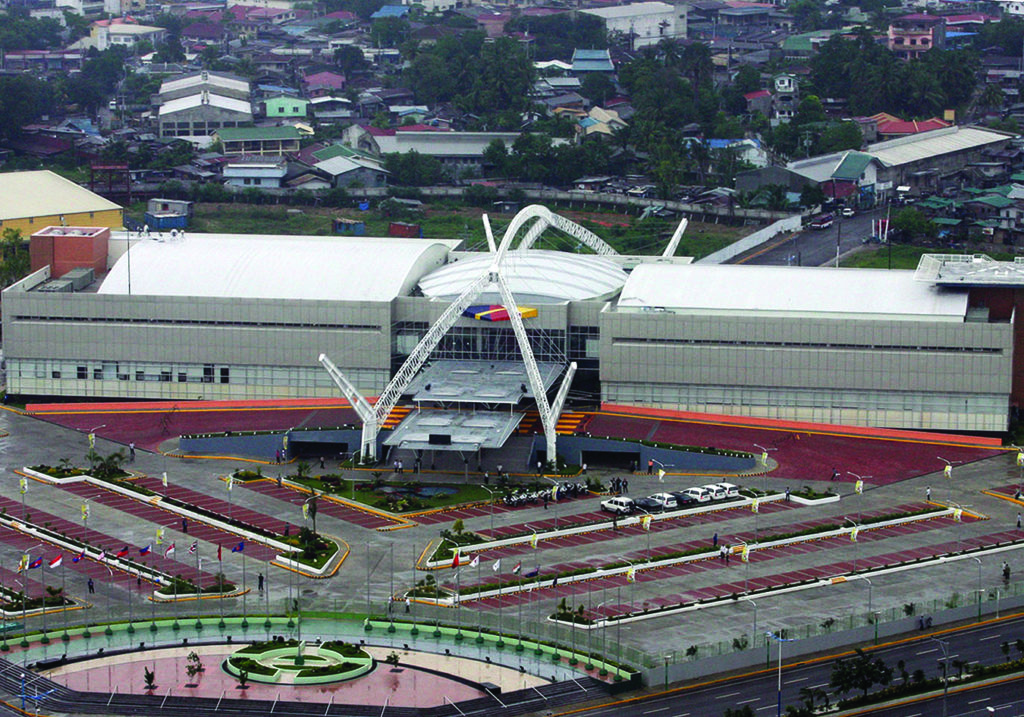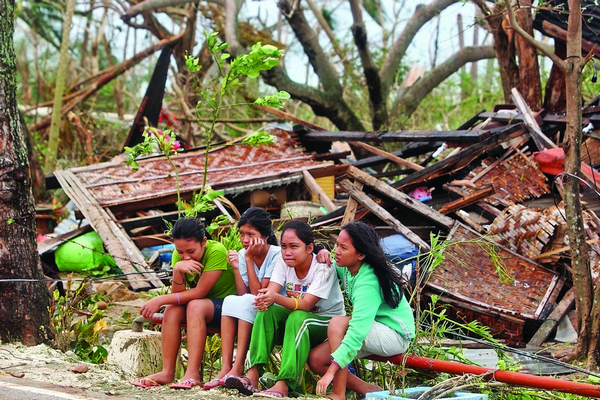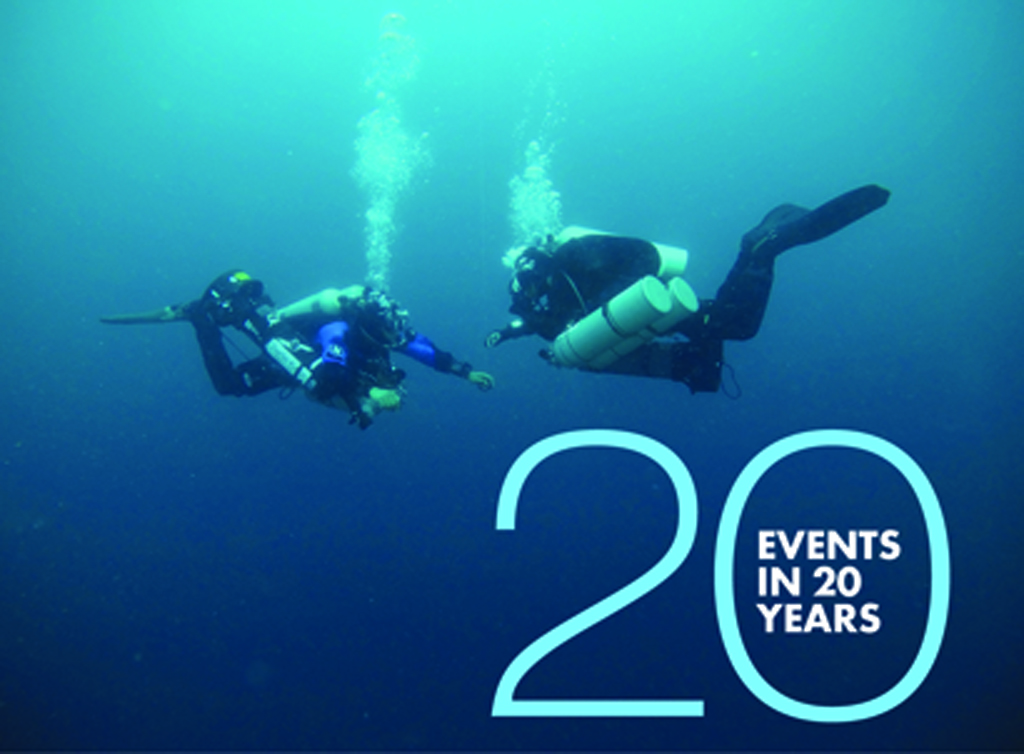In the 20 years since the maiden issue of Cebu Daily News on Feb. 8, 1998, it has become a witness to and chronicler of the events that shaped Cebu in the last two decades.
These include celebrations, deaths, political upheavals, controversies, calamities, and religious events that have left an indelible mark in the hearts and minds of the Cebuanos.
Here are the 20 most significant events covered by CDN in the last 20 years:
1. SEA TRAGEDIES
Three sea mishaps caused so much misery and grief among Cebuanos. These are the sinking of the Cebu-bound MV Princess of the Orient off Batangas City on Sept. 6, 1998, where 150 persons, mostly Cebuanos, perished; the sinking of the Princess of the Stars on June 21, 2008, in Romblon at the height of Typhoon Frank where 768 people lost their lives; and the collision of the passenger ferry St. Thomas Aquinas and cargo vessel MV Sulpicio Express Siete off Lawis Ledge, Talisay City on Aug. 16, 2013, that killed 116 people.
2. WATER TERRORISM
It was March 1999 and it was the first time that Cebuanos became widely aware of the term “water terrorism”— after townsfolk of Samboan in southern Cebu accused their then Mayor Crisologo Abines of shutting off the water supply because they did not back him in the last elections. Some residents then rose in protest and armed themselves to guard their town’s two Catholic priests, Fathers Brandit Bohol and Enrico Gabutan, after they were threatened for issuing statements against Abines.
3. THE CHIONG SISTERS’ KIDNAP-SLAY, MYSTERIOUS SUICIDE OF THE PRESIDING JUDGE OF CEBU’S “TRIAL OF THE DECADE”
The kidnapping of Chiong sisters Marijoy, 20, and Jacqueline, 23, happened in the evening of July 16, 1997 as they waited for a ride outside Ayala Center Cebu. Marijoy’s handcuffed body was found in a ravine in Carcar City two days after. Jacqueline remains missing to this day.
The kidnapping happened before CDN began its operation but in the succeeding years, it chronicled the twists and turns in the riveting tale – the anguish of the mothers of both the victims and the accused; the double life sentences meted in May 5, 1999 by Regional Trial Court Judge Martin Ocampo to the sisters’ seven alleged abductors, including young men from prominent Cebuano families who professed innocence to the crime: Paco Larrañaga, Josman Aznar, Rowen Adlawan, Alberto Cano, Ariel Balansag and brothers James Anthony and James Andrew Uy; and the suicide of Judge Ocampo a few months later, on Oct. 7, 1999.
In 2004, the Supreme Court meted the death penalty on the seven convicts. In 2006, however, they got a reprieve when the death penalty in the Philippines was abolished.
By 2010, Larrañaga, who later in 2012 was the subject of an award-winning documentary “Give Up Tomorrow” that argued about his wrongful conviction, began serving a life sentence in a Spanish prison where he was transferred by virtue of a treaty that recognized his Spanish citizenship as the son of a Basque resident.
4. MARCELO FERNAN BRIDGE
It was an awesome sight to behold. Nothing like it was seen in the Philippines and Cebu was the first to have one: an extradosed cable-stayed four-lane bridge that was 1,237 meters (1.2 kilometers) long and only previously seen in First World countries.
The bridge, named after the late former Supreme Court Chief Justice Marcelo Fernan, also a former Senate president and one of Cebu’s noted legal and political luminaries, is the second bridge that crosses the Mactan Channel to link mainland Cebu to Mactan Island, which hosts the Mactan-Cebu International Airport (MCIA), the Mactan Export Processing Zone (MEPZ) and high-end resorts.
The bridge was built to ease traffic congestion at the first Mandaue-Mactan Bridge and was funded by the Japanese Government through its Official Development Assistance (ODA) loan.
It was inaugurated by then President Joseph Estrada in August 1999 or a year after its construction started.
Today, the Marcelo Fernan Bridge is one of the most photographed bridges in the country and an important landmark in Cebu.
Although the country has a second cable-stayed bridge, the Macapagal Bridge built in Butuan City in 2007, the majesty of the Marcelo Fernan Bridge remains unparalleled.

The story of the conviction of Ruben Ecleo Jr. for the killing of his wife is CDN’s headline story for that April 2012 issue.
5. RUBEN ECLEO JR.: THE CULT LEADER, MURDER CONVICT, FUGITIVE
Cult leader Ruben Ecleo Jr. was convicted of killing his wife Alona Bacolod-Ecleo on April 12, 2012 a decade after he committed the crime. Alona was strangled in their house in Sitio Banawa, Barangay Guadalupe, Cebu City on Jan. 3, 2002. Her remains were found inside a plastic bag in Dalaguete town in southern Cebu three days later. Ecleo, the supreme master of the Philippine Benevolent Missionaries Association (PBMA), was tagged as the suspect and fled to Dinagat Island. He was arrested following a gunbattle between the police and his followers on June 18, 2002.
Ecleo walked out of jail in 2004 after he was allowed to post a P1 million bail, citing his worsening health condition. In 2011, an arrest warrant was issued against him after he failed to attend his parricide case hearing three times and jumped bail. He was convicted for murder in absentia in April 2012. He is a fugitive to this day.
6. VIGILANTE KILLINGS IN CEBU
The so called “vigilante killings” in Cebu City started on Christmas eve of 2004 — two days after a frustrated Cebu City Mayor Tomas Osmeña declared “open season” for police officers against criminals. Osmeña placed a P20,000 bounty on each criminal that a police officer could permanently disable or neutralize. He made the offer after a spate of armed robberies in Cebu and after knowing that 50 percent of the crimes in the region for the year happened in Cebu City.
A day after the announcement the death count started, with the killing of a robbery suspect allegedly operating at the port area. The death tally continued until 2007, reaching nearly 200. As the death count grew, so did the calls from the business sector, church leaders, and lawyers to stop the killings. Police insisted they were investigating the killings, but the lack of witnesses hindered their investigations.
7. MEGA SHABU LAB CASE
Agents of the Philippine Drug Enforcement Agency (PDEA) raided the Cap R Us warehouse in Barangay Umapad, Mandaue City on Sept. 24, 2004.
They arrested nine Chinese nationals and confiscated 675 kilograms of shabu worth P1.3 billion.
The warehouse turned out to be where shabu was being “cooked” or produced. The warehouse was considered as one of the biggest shabu laboratories in the country.
On Feb. 23, 2012, 11 — the nine Chinese nationals and two Filipinos — were found guilty and sentenced to life imprisonment for conniving to manufacture 675 kilograms of shabu. The two owners of the warehouse, however, were cleared of liability.
8. BALILI GATE
The Cebu Capitol under then Gov. Gwendolyn Garcia purchased in 2008 a 24.7 hectare beachfront property in Naga City from the Balili family for P98.9 million with plans to convert it into an eco-industrial zone.
The deal, however, was put in the spotlight in 2012 after it was discovered that most of the property was under water and planted with mangroves. The controversial lot purchase, dubbed as “Baliligate,” led to the filing of a graft case against Garcia, five other Capitol officials and the land owners.
On Sept. 10, 2017, incumbent Gov. Hilario Davide III announced his plan to sell the property to the Naga City government.

The Cebu International Convention Center is seen at the height of its grandeur on 2007.
9. CICC AND LAMPPOST CONTROVERSIES
The Cebu International Convention Center (CICC) was built for P800 million by the Cebu provincial government to host the main meetings of the 12th Association of Southeast Asian (Asean) Summit held in Cebu from Jan. 12-15, 2007.
The property, however, was besieged by allegations of corruption and slowly lost its grandeur through the years. It was left in a sorry state of disrepair after it was damaged by a 7.2 magnitude earthquake on Oct. 15, 2013 that hit Cebu and Bohol, and, barely a month later, on Nov. 8, 2013, by Super Typhoon Yolanda. In 2017, Capitol sold the CICC to the Mandaue City government for P300 million.
Another controversy that hounded Cebu’s hosting of the 12th Asean Summit was the finding that 1,800 China-made decorative lampposts installed along the Asean Summit ceremonial routes in Cebu, Mandaue and Lapu-Lapu cities were overpriced nearly ten times than their actual cost. In Mandaue City, for example, the 300 lampposts that were bought by DPWH for P25 million were found by the Office of the Ombudsman to only cost P7.48 million, or were overpriced by 233 percent.
The lamppost scam led to the filing of graft charges against the contractor, Department of Public Works and Highways in Central Visayas (DPWH-7) officials, and local government officials at the Visayas Ombudsman in March 2007.
The graft cases against the contractors, former DPWH-7 officials and local government officials are still pending at the Sandiganbayan.

An image captured after Super Typhoon Yolanda devastated the northern Cebu towns on Nov. 8, 2013.
10. 2013: A YEAR OF CALAMITIES — EARTHQUAKE AND YOLANDA
Cebu and other parts of Visayas reeled from two major calamities in 2013. The first was the October 15, 2013 magnitude 7.2 earthquake that shook Bohol and Cebu.
Bohol was devastated with several of its centuries old churches left into a pile of rubble and killing at least 100 people. In Cebu, several churches were damaged including the centuries old bell tower of the Basilica Minore del Sto. Nino church.
As people started rebuilding and picking up the pieces, a few weeks later on Nov. 8, 2013,
Supertyphoon Yolanda, entered the country and made a landfall in Tacloban City in Leyte. But Yolanda (international name Haiyan), was so destructive it also left a wide swath of death and destruction not just in Leyte but across the Visayas, including northern Cebu. To this day, many affected areas have still to fully recover from the damage wrought by Yolanda.
11) CHOP CHOP MURDERS OF TALISAY
In July 24, 2008, the chopped bodies of Eva Mae Peligro, 24, and her cousin, Gwendolyn Balasta, 26, were found inside garbage bags and dumped in various locations in the cities of Talisay and Naga and in Minglanilla town.
According to the police investigation, the two women were strangled before they were mutilated inside their residence in a private subdivision in Talisay City.
The suspect, Richard Gudelosao, was convicted on Feb. 28, 2016 of the charge of double murder and was meted a jail term of up to 80 years.
Police said the murders stemmed from bitter relations between Gudelosao and Peligro, the fiancée of his brother.
12) 51st IEC IN CEBU
Cebu successfully held the weeklong 51st International Eucharistic Congress from Jan. 24 to Jan. 31, 2016. Hundreds of thousands of faithful attended the events, which opened with an estimated 350,000 faithful including 12,000 participants from across the world during the opening Mass at the Plaza Independencia.
Security was tight and the weeklong activity ended with the Statio Orbis or “Stations of the World” Mass at the South Road Properties, which was attended by nearly a million people.
13) VIDAL’S PASSING
Cebuanos mourned the death of Cebu Archbishop Emeritus Ricardo Cardinal Vidal early in the morning on Oct. 18, 2017.
Vidal, 86, died of septic shock, a condition when the blood pressure drops to a dangerously low level after a severe blood infection, while admitted at the Intensive Care Unit of the Perpetual Succour Hospital in Cebu City.
People from all walks of life including President Rodrigo Duterte visited his wake at the Cebu Metropolitan Cathedral to pay their last respect for the prelate who was well loved not only by the Cebuanos.
Duterte declared his burial day on Oct. 26, 2017 a special non-working holiday in Cebu. Police said at least 55, 000 people joined Vidal’s mid-morning funeral procession that traversed a 1.5-kilometer route from the Cebu Metropolitan Cathedral to downtown Cebu City before it finally ended at his final resting place at the cathedral’s mausoleum.
14) THE DISAPPEARANCE OF GISELA BONIEL
The love story between Mayor Gisela Boniel of Bien Unido town in Bohol and Rey Niño Boniel, the town’s former mayor and now Provincial Board Member of Bohol, reached a tragic end.
Gisela’s body has not been found to date while Rey Niño is now detained at the Cebu Provincial Detention and Rehabilitation Center (CPDRC) on accusations that he killed his wife and had her body dumped into the waters off Punta Engaño in Mactan Island.
Angela Leyson, Gisela’s friend, said the couple were fighting over financial matters before Gisela, a pilot, went missing on the evening of June 7, 2017.
15) ABU SAYYAF IN BOHOL
People’s vigilance resulted to the discovery of at least 11 Abu Sayyaf members who arrived in Inabanga town in Bohol Province on April 10, 2017. Early morning of the next day, the firefight ensued between government troops and the ASG members forcing at least 700 town residents to flee to safety.
Government troops killed the ASG leader, Muamar Askali alias Abu Rami, and five of his men on the second day of the armed clash. But the clashes also cost the life of eight government troops, from the Armed Forces of the Philippines (AFP) and the Philippine National Police (PNP).
Outnumbered by the state troops, the five remaining ASG members fled into the mountains of Bohol province. The seach for the stragglers went on until May 15, 2017, when soldiers killed the last two remaining ASG members – Abu Ubayda and Abu Asis – after they took two Calape town residents.

SAVAGE GIRL. A mug shot of Liezyl Margallo, 23, who was wanted in Cagayan de Oro City for child trafficking was arrested in a resort on Bantayan Island in Cebu on Jan. 27, 2017.
16) SAVAGE GIRL
Seemingly innocent-looking Liezyl Margallo, 23, lived a fancy life before she was arrested by the National Bureau of Investigation in Central Visayas (NBI-7) in a resort in Sta. Fe town on Bantayan Island on Jan. 27, 2017 for her involvement in the online trafficking and torture of children in her native Mindanao.
The next day, she was flown to Cagayan de Oro City to face a string of charges for violating Republic Act 9995 (Anti-Photo and Video Voyeurism Act of 2009), RA 9610 (Special Protection of Children Against Child Abuse, Exploitation and Discrimination Act) and RA 9208 (Anti-Trafficking in Persons Act of 2003) along with her live-in partner Peter Gerard Scully, an Australian national, who was arrested in Malaybalay, Bukidnon in February 2015.
Scully and Margallo were accused of luring female street children and scavengers into their care with a promise of a good life, but the minors ended up in front of a video camera, forced to perform sexual acts and tortured while being filmed.
They sold their videos to depraved persons across the world for at least $10,000 per live streaming.
17) CEBU CITY’S POLITICS
Their almost two decades of alliance ended in 2011 after former Cebu City Mayor Michael Rama announced that he was leaving Bando Osmeña Pundok Kauswagan (BOPK) led by his erstwhile mentor, Tomas Osmeña, to be his own man.
Rama went on to lead his own political party, Barug Team Rama, after he defeated now Osmeña in the May 2013 mayoral race by a slim margin of 6,000 votes.
But Osmeña was quick to regain his political stock after he foiled Rama’s re-election bid in May 2016 by a wide margin of 30,000 votes.
But Osmeña’s runningmate, Nestor Archival, lost to re-electionist Vice Mayor Edgar.
An even bigger fight is yet to be seen in the May 2019 election. This early, at least three names have been floated as Osmeña’s opponent: Rama, Labella and Presidential Assistant for the Visayas Michael Dino.
18) GOVERNOR GWEN’S SUSPENSION
In December 2012, Cebu Gov. Gwendolyn Garcia defied the Office of the President’s order dated Dec. 19, 2012 to suspend her for six months for grave abuse of authority in bypassing the Office of the Vice Governor and the Provincial Board in the hiring of contractual workers.
The Department of Interior and Local Government designated Vice Governor Agnes Magpale as acting governor.
Garcia refused to vacate her office, stayed holed up in her office for over a month and she even dared the police to forcibly remove her.
Since the issuance of the suspension order, she only left her office once to dance at the Cebu City Sports Center during the Jan. 20, 2013 Sinulog grand parade.
On Jan. 30, 2013, Garcia sneaked out of the Capitol to attend a commitment in Oslob town in southern Cebu. Police took advantage of her absence and locked the Office of the Governor.
Garcia has since been elected as the representative of the third district of Cebu and is now the Deputy House Speaker of the 17th Congress.
19 NARCO POLITICS/EJKS
Eradicating the drug menace hounding the country has been one of the major campaign promises of President Rodrigo Duterte.
But soon after Duterte assumed office in June 30, 2016, the death toll in the drug war began rising at an alarming speed, with data from the Philippine National Police showing that barely six months later, or as of Dec. 14, 2016, 2,102 drug suspects had been killed in alleged legitimate police operations nationwide, while 3,993 others were shot dead by unknown assailants. It also showed 40,932 drug suspects arrested in the country.
In Central Visayas, which included Cebu, 157 drug suspects were killed in different operations in the region, while 352 others were gunned down by unknown assailants. Extrajudicial killings or EJKs has alarmed the church, human rights advocates and even the European Union. Despite this, the President and the war against drugs continued without letup.
The police implemented their Operation Tokhang where drug personalities would be visited by police officers to convince them to give up the trade or suffer the consequences. That was on the first Oplan Tokhang.
In Aug. 7, 2016, President Duterte announced his narco list or drug watchlist of judges, mayors, and police officials allegedly linked to drugs. Former Cebu City Mayor Michael Rama, Daanbantayan Mayor Vicente Loot. Rama and Loot had vehemently denied the allegations.
20) RECOGNITIONs, ECONOMIC DRIVERS
Tourism has been one of the economic drivers of Cebu. In the first half of 2017 alone, a Department of Tourism data showed that an estimated 2 million tourists visited Cebu. The industry have grown through the years and the international recognition like being in the Top Islands of the World list of the Travel+Leisure magazine in 2009 helped in boosting the sector.
The business process outsourcing industry (BPO) also continues to contribute to Cebu’s economy. Based on industry estimates, Metro Cebu is home to about 140,000 IT-BPM workers in 2017.
It also has its share of recognition like being included in the “The Emerged BPO destination of the world” list from “Emerging BPO destination of the world” in 2009. Cebu City also placed 7th in Tholons’ top outsourcing destinations in 2016, although it slipped to 12th place in 2017 due to changes in the research criteria.
Disclaimer: The comments uploaded on this site do not necessarily represent or reflect the views of management and owner of Cebudailynews. We reserve the right to exclude comments that we deem to be inconsistent with our editorial standards.

